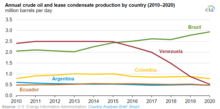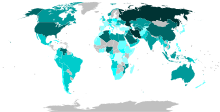Energy policy of Venezuela
[2] Venezuela is also amongst world leaders in hydroelectric production, supplying a majority of the nation's electrical power through the process.
On 29 August 1975, during the tenure of President Carlos Andrés Pérez, "Law that Reserves the Hydrocarbon Industry to the State" was enacted and the state-owned company Petróleos de Venezuela (PDVSA) was created to control all oil businesses in the Venezuelan territory.
[5] Since 2010, when the heavy oil from the Orinoco Belt was considered to be economically recoverable, Venezuela has had the largest proved reserves of petroleum in the world, about 298 billion barrels.
The leading oil company is Petróleos de Venezuela S.A. (PDVSA), which according to Venezuelan authorities produces 3.3 million barrels per day (520,000 m3/d).
Venezuela's main oil fields are located at four major sedimentary basins: Maracaibo, Falcón, Apure, and Oriental.
[1] Nearly 35% of gross natural gas output are re-injected in order to boost or maintain reservoir pressures, while smaller amounts (5%) are vented or flared.
The largest hydroplant is the Guri dam with 10,200 MW of installed capacity, which makes it the third-largest hydroelectric plant in the world.
The largest power companies are state-owned CVG Electrificación del Caroní (EDELCA), a subsidiary of the mining company Corporación Venezolana de Guayana (CVG), and Compania Anonima de Administracion y Fomento Electrico (CADAFE) accounting respectively for approximately 63% and 18% of generating capacities.
In 2007, PDVSA bought 82.14% percent of Electricidad de Caracas (EDC) from AES Corporation as part of a renationalization program.
Under Petrocaribe, Venezuela would offer crude oil and petroleum products to Caribbean nations under preferential terms and prices.
The payment system allows for a few nations to buy oil on market value but only a certain amount is needed up front; the remainder can be paid through a 25-year financing agreement on 1% interest.
In addition it allows for nations to pay part of the cost with other products provided to Venezuela, such as bananas, rice, and sugar.
[7] In 2006, the construction of the Trans-Caribbean gas pipeline, which wpiñd connect Venezuela and Colombia with extension to Panama (and probably to Nicaragua) began.
[13] Venezuela may suffer a deterioration of its power in international affairs if the global transition to renewable energy is completed.
[17] As of 2019, PetroCaribe has mostly dried up because of Venezuela's eroded domestic production and refining, but political and commercial ties in some prominent cases have endured.
Critics say PetroCaribe suppressed the development of renewable energy, burdened these small nations with billions of dollars in debt – and spurred corruption.



